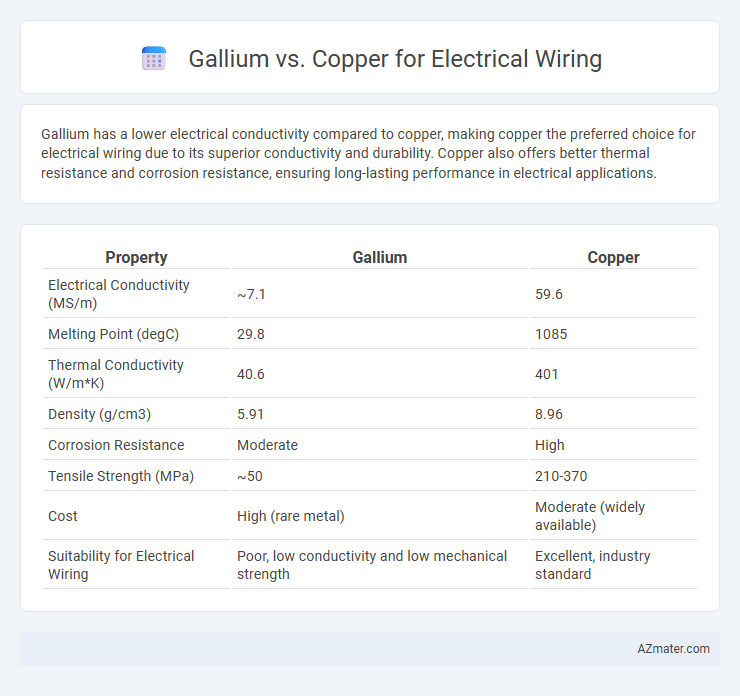Gallium has a lower electrical conductivity compared to copper, making copper the preferred choice for electrical wiring due to its superior conductivity and durability. Copper also offers better thermal resistance and corrosion resistance, ensuring long-lasting performance in electrical applications.
Table of Comparison
| Property | Gallium | Copper |
|---|---|---|
| Electrical Conductivity (MS/m) | ~7.1 | 59.6 |
| Melting Point (degC) | 29.8 | 1085 |
| Thermal Conductivity (W/m*K) | 40.6 | 401 |
| Density (g/cm3) | 5.91 | 8.96 |
| Corrosion Resistance | Moderate | High |
| Tensile Strength (MPa) | ~50 | 210-370 |
| Cost | High (rare metal) | Moderate (widely available) |
| Suitability for Electrical Wiring | Poor, low conductivity and low mechanical strength | Excellent, industry standard |
Introduction to Gallium and Copper in Electrical Wiring
Gallium is an emerging material in electrical wiring characterized by its excellent conductivity, low melting point, and resistance to corrosion, making it a promising alternative to traditional metals. Copper, a widely used metal in electrical wiring, offers superior electrical conductivity, mechanical strength, and thermal stability, ensuring efficient energy transmission and durability. The comparison between gallium and copper in wiring applications focuses on their conductivity, cost-effectiveness, and material properties relevant to specific electrical engineering needs.
Electrical Conductivity: Gallium vs Copper
Copper exhibits superior electrical conductivity at approximately 5.96 x 10^7 S/m, far surpassing Gallium's conductivity of about 7.14 x 10^6 S/m. This significant difference makes Copper the preferred choice for electrical wiring, ensuring minimal energy loss and efficient current flow. Gallium, with its lower conductivity and higher cost, is less practical for conventional wiring but may offer niche applications in specialized electronics.
Thermal Properties Comparison
Gallium has a thermal conductivity of approximately 29 W/m*K, significantly lower than copper's 401 W/m*K, meaning copper dissipates heat more efficiently in electrical wiring applications. Copper's high thermal conductivity reduces the risk of overheating and improves the overall safety and longevity of electrical cables. Gallium's lower thermal conductivity limits its effectiveness for thermal management in wiring despite its other unique properties.
Corrosion Resistance and Longevity
Gallium exhibits poor corrosion resistance in electrical wiring applications due to its high reactivity and tendency to form brittle intermetallic compounds when in contact with other metals. Copper offers superior corrosion resistance, maintaining structural integrity and electrical conductivity over extended periods in various environments. Longevity-wise, copper wiring significantly outperforms gallium, making it the preferred choice in durable electrical installations.
Mechanical Strength and Flexibility
Gallium has significantly lower mechanical strength compared to copper, making it unsuitable for traditional electrical wiring where durability and tensile strength are critical. Copper exhibits high tensile strength and excellent flexibility, allowing it to withstand bending and stretching without breaking, essential for reliable electrical connections. The combination of copper's superior mechanical properties and corrosion resistance makes it the preferred material for wiring over gallium.
Cost Analysis: Gallium vs Copper
Copper remains the preferred choice for electrical wiring due to its low cost and abundant availability, with prices averaging around $4 to $5 per pound compared to gallium's significantly higher cost exceeding $300 per kilogram. Gallium's expense stems from its scarcity and complex extraction process, making it economically unfeasible for large-scale wiring applications despite its favorable electrical conductivity and melting point. Cost analysis clearly shows copper as the more practical and cost-effective option for electrical wiring projects, especially where budget constraints are critical.
Environmental Impact and Sustainability
Gallium, being a less abundant and more resource-intensive metal to extract than copper, poses greater environmental challenges in mining and refining processes, leading to increased ecological footprint. Copper, widely recycled and highly efficient in conductivity, supports sustainability through established circular economies and reduced energy consumption in production. Transitioning to copper wiring leverages its lower environmental impact, recyclability, and long-term availability compared to gallium, which remains constrained by limited supply and higher extraction emissions.
Availability and Production Scalability
Copper remains the most widely used material for electrical wiring due to its abundant availability and well-established global production infrastructure, supporting large-scale manufacturing and consistent supply. Gallium, though offering unique electrical properties, is considerably rarer and primarily produced as a byproduct of aluminum and zinc refining, limiting its availability for widespread wiring applications. The scalability of gallium production is constrained by limited raw material sources and extraction costs, making copper the more practical and economically viable choice for mass electrical wiring projects.
Safety Concerns and Handling Requirements
Gallium poses significant safety concerns in electrical wiring due to its ability to weaken and embrittle aluminum and other metals, leading to structural failures and potential electrical hazards. Copper, known for its excellent conductivity and mechanical durability, remains the standard for wiring with well-established handling protocols ensuring safe installation and long-term reliability. Proper handling of gallium requires specialized gloves and containment measures to prevent contamination and metal degradation, while copper wiring follows conventional electrical safety guidelines.
Future Prospects in Electrical Wiring Technologies
Gallium's exceptional conductivity and flexibility offer promising advantages for future electrical wiring technologies, particularly in applications requiring lightweight and high-performance materials. Copper remains the industry standard due to its proven reliability, cost-effectiveness, and excellent electrical conductivity, but its limitations in weight and corrosion resistance drive the search for alternatives. Innovations in gallium-based alloys and nanomaterials could revolutionize wiring systems by enabling more efficient, durable, and adaptable electrical networks in smart grids and flexible electronics.

Infographic: Gallium vs Copper for Electrical wiring
 azmater.com
azmater.com